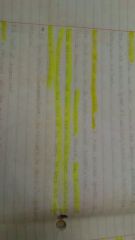![]()
![]()
![]()
Use LEFT and RIGHT arrow keys to navigate between flashcards;
Use UP and DOWN arrow keys to flip the card;
H to show hint;
A reads text to speech;
20 Cards in this Set
- Front
- Back
|
Homeostasis |
The body's maintenance of a relatively stable internal physiological environment |
|
|
Dynamic equilibrium |
A star of balance achieved within an environment as a result of internal control mechanisms |
|
|
Control mechanisms |
Goose bumps,shivering,transfer of heat energy and sweating |
|
|
Vascoconstriction |

|
|
|
Vasodiliation |
Blood vessels near the skin dilate to transmit more blood to the skins surface where it is released |
|
|
Negative feedback loop |
Is a process that detects and reverses deviations from normal body constants |
|
|
Negative feedback parts |
Receptor, integrator and effector |
|
|
Receptors |
Send nerve impulses (stimuli) to the brain response to environmental info |
|
|
Integrator |
Sends messages to effectors |
|
|
Effectors |
Cause a change to internal conditions cause the body to make heat or conserve heat |
|
|
Positive feedback |
Act to increase the strength of the stimuli |
|
|
Sphincters |
Two rings of muscles that control the exit of the bladder one is voluntarily controlled by the other is involuntary by the brain |
|
|
Kidney's principle function |
To filter the blood in order to remove cellular waste products from the body |
|
|
Kidney 3 sections |
The outer cortex, medulla and inner pelvis |
|
|
What is within the cortex and medulla of each kidney? |
About one million tiny filters called nephrons |
|
|
Nephron's 5 parts |
Bowman's capsule, proximal tubule , loop of Henle , distal tubes and collecting duct |
|
|
Reabsorption |
Process where materials required by the body are removed from the filtrate and returned to the bloodstream |
|
|
Isotonic |
A fluid that has the same concentration of water solutes as that in the cells surrounding it |
|
|
Antagonistic hormones |
Hormones that have opposing psychological properties but that work together |
|
|
Islets of Langerhans |
Groups of cells in the pancreas that produce insulin and glycogen |

